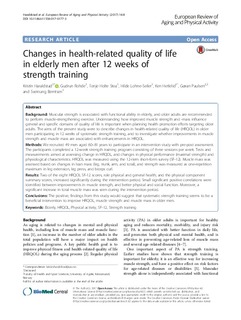| dc.contributor.author | Haraldstad, Kristin | |
| dc.contributor.author | Rohde, Gudrun E. | |
| dc.contributor.author | Stea, Tonje Holte | |
| dc.contributor.author | Lohne-Seiler, Hilde | |
| dc.contributor.author | Hetlelid, Ken Joar | |
| dc.contributor.author | Paulsen, Gøran | |
| dc.contributor.author | Berntsen, Sveinung | |
| dc.date.accessioned | 2017-08-11T07:51:41Z | |
| dc.date.available | 2017-08-11T07:51:41Z | |
| dc.date.created | 2017-08-09T11:10:33Z | |
| dc.date.issued | 2017 | |
| dc.identifier.issn | 1813-7253 | |
| dc.identifier.uri | http://hdl.handle.net/11250/2450492 | |
| dc.description.abstract | Background
Muscular strength is associated with functional ability in elderly, and older adults are recommended to perform muscle-strengthening exercise. Understanding how improved muscle strength and -mass influence general and specific domains of quality of life is important when planning health promotion efforts targeting older adults. The aims of the present study were to describe changes in health-related quality of life (HRQOL) in older men participating in 12 weeks of systematic strength training, and to investigate whether improvements in muscle strength and muscle mass are associated with enhancements in HRQOL.
Methods
We recruited 49 men aged 60–81 years to participate in an intervention study with pre-post assessment. The participants completed a 12-week strength training program consisting of three sessions per week. Tests and measurements aimed at assessing change in HRQOL, and changes in physical performance (maximal strength) and physiological characteristics. HRQOL was measured using the 12-item short-form survey (SF-12). Muscle mass was assessed based on changes in lean mass (leg, trunk, arm, and total), and strength was measured as one-repetition maximum in leg extension, leg press, and biceps curl.
Results
Two of the eight HRQOL SF-12 scores, role physical and general health, and the physical component summary scores, increased significantly during the intervention period. Small significant positive correlations were identified between improvements in muscle strength, and better physical and social function. Moreover, a significant increase in total muscle mass was seen during the intervention period.
Conclusions
The positive, findings from this study would suggest that systematic strength training seems to be a beneficial intervention to improve HRQOL, muscle strength and muscle mass in older men. | nb_NO |
| dc.language.iso | eng | nb_NO |
| dc.publisher | BioMed Central | nb_NO |
| dc.rights | Navngivelse 4.0 Internasjonal | * |
| dc.rights.uri | http://creativecommons.org/licenses/by/4.0/deed.no | * |
| dc.title | Changes in health-related quality of life in elderly men after 12 weeks of strength training | nb_NO |
| dc.type | Journal article | nb_NO |
| dc.type | Peer reviewed | nb_NO |
| dc.description.version | publishedVersion | nb_NO |
| dc.source.volume | 14 | nb_NO |
| dc.source.journal | European Review of Aging and Physical Activity | nb_NO |
| dc.source.issue | 1 | nb_NO |
| dc.identifier.doi | 10.1186/s11556-017-0177-3 | |
| dc.identifier.cristin | 1485121 | |
| dc.description.localcode | © The Author(s) 2017. This article is distributed under the terms of the Creative Commons Attribution 4.0 International License (http://creativecommons.org/licenses/by/4.0/), which permits unrestricted use, distribution, and reproduction in any medium, provided you give appropriate credit to the original author(s) and the source, provide a link to the Creative Commons license, and indicate if changes were made. The Creative Commons Public Domain Dedication waiver(http://creativecommons.org/publicdomain/zero/1.0/) applies to the data made available in this article, unless otherwise stated. | nb_NO |
| cristin.unitcode | 194,18,23,20 | |
| cristin.unitname | Seksjon for sykepleie | |
| cristin.ispublished | true | |
| cristin.fulltext | original | |
| cristin.qualitycode | 1 | |

